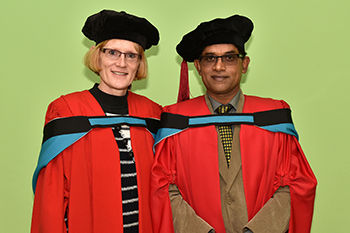Latest News Archive
Please select Category, Year, and then Month to display items
10 March 2022
|
Story Anthony Mthembu
|
Photo Unsplash
 The No Student Hungry team gearing up to start distributing food parcels to the selected students.
The No Student Hungry team gearing up to start distributing food parcels to the selected students.
The UFS is one of the many institutions of higher learning where food insecurity is an active issue. However, the
No Student Hungry Programme is one of the initiatives launched at the university to assist in fighting food insecurity at the institution.
The purpose of the programme
Since its inception in 2011, the initiative has assisted many students in acquiring a healthy meal. Additionally, the Food Environment Office also hands out food packages, so that students can continue to achieve academically. “We are trying to develop a healthy environment for students and make it easier for them to have a nice and healthy meal,” stated Annelize Visagie, who heads the Food Environment Office at the UFS. The Food Environment programme is spread out on all three campuses, each with its own facilitators. Furthermore, the programme mainly caters for students who are not funded by the National Student Financial Aid Scheme (NSFAS) but who are excelling academically. The abovementioned students apply for assistance online, and a list is then drawn up of students who receive assistance for the year.
Alternative solutions to keep the initiative running
On the Bloemfontein Campus, the No Student Hungry Programme will be catering for 200 students in the 2022 academic year, assisting them with a daily nutritious meal. Additional food parcels are also handed out to provide further assistance. “We give food parcels to the students on the list every Tuesday and Thursday at the Thakaneng Bridge,” Visagie highlighted. However, she argues that catering for the student population through this programme can be a challenge, as the demand for assistance is growing rapidly and the ability to assist is limited. The programme relies on partnerships and sponsors to assist the student body. In fact, the coordinators of the programme currently have a memorandum of understanding with Tiger Brands according to which they deliver around 100 food parcels for distribution.
In addition, the coordinators have put in place alternative measures to ensure that they can provide more food to students. “The
Kovsie Act Office, in partnership with the
Department of Sustainable Food Systems and Development, has started a food garden where healthy and nutritious produce are grown, in order to add value to the distribution,” she indicated. Although the programme can only assist to a point, students who are in desperate need of assistance are never turned away. In fact, the
Social Support Unit at Thakaneng Bridge usually assists students with food vouchers for a maximum of four days.
A commitment to teaching healthy eating habits
The programme is not only committed to curbing food insecurity, but also to ensuring that students have a healthy and balanced diet. As such, a booklet is being issued by the
Department of Nutrition and Dietetics in collaboration with the Department of Sustainable Food Systems and Development, which contains ways in which students can make a healthy meal using some of the ingredients offered in the food parcels.
“We want to teach students how to eat healthy in the cheapest way, because they don’t have a lot of money to buy expensive food products,” Visagie argued.
Using sugar to make the world a sweeter place
2017-10-13

Dr Deepack Santchurn, former PhD student in the
Department of Plant Sciences at the UFS,
and plant breeder in the Mauritius Sugar Industry
Research Institute, with Prof Maryke Labuschagne, left,
Dr Santchurn’s study leader.
Photo: Charl Devenish
Besides it mainly being used for sugar production, sugarcane has emerged as an important alternative for providing clean renewable energy. Dr Deepack Santchurn, who works in the sugarcane breeding department of the Mauritius Sugar Industry Research Institute (MSIRI), believes if he could contribute towards a more environment-friendly and renewable energy through the use of sugarcane biomass, he would consider himself having made a great leap towards a better world.
Sugarcane is mostly known and exploited for the sugar in its cane stem. According to Dr Santchurn it is not the only thing the crop does well. “Together with certain grasses, it is the finest living collector of sunlight energy and a producer of biomass in unit time. Sugarcane is now recognised worldwide as a potential renewable and environment-friendly bioenergy crop.”
Significantly more bioenergy can be produced from sugarcane if the production system is not focused on the production and recovery of sucrose alone but on the maximum use to the total above-ground biomass. Diversification within the sugarcane industry is of paramount importance.
He has been able to identify a few high biomass varieties that can be exploited industrially. One of the varieties is a commercial type with relatively high sugar and low fibre in the cane stem. Dr Santchurn explains: “Its sucrose content is about 0.5% less than the most cultivated commercial variety in Mauritius. Nevertheless, its sugar yield and above-ground biomass yield surpass those of the commercial varieties by more than 24%. The genetic gains compared to commercial varieties were around +50% for total biomass yield and +100% for fibre yield. Its cultivation is strictly related to bio-energy production and the extracted juice can be used as a feed-stock for ethanol and other high-value products.”
Dr Santchurn received his PhD at the UFS’s Department of Plant Sciences during the Winter Graduation Ceremonies in June this year. His study leader was Prof Maryke Labuschagne from the Department of Plant Sciences.